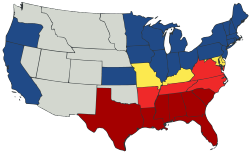James Buchanan
James Buchanan Jr. (April 23, 1791 – June 1, 1868) was an American politician who served as the 15th president of the United States.
James Buchanan | |
|---|---|
 Painting by George Peter Alexander Healy, 1859 | |
| 15th President of the United States | |
| In office March 4, 1857 – March 4, 1861 | |
| Vice President | John C. Breckinridge |
| Preceded by | Franklin Pierce |
| Succeeded by | Abraham Lincoln |
| Personal details | |
| Born | April 23, 1791 Cove Gap, Pennsylvania |
| Died | June 1, 1868 (aged 77) Lancaster, Pennsylvania |
| Nationality | American |
| Political party | Democratic |
| Religion | Presbyterianism |
Buchanan was the only president not to have married. His niece, Harriet Lane, stood in as First Lady. An experienced politician, he became president in 1857. His support of slavery and his actions before the American Civil War broke out have been criticized by scholars.
In 1860, Buchanan announced that he would not be taking part in the election. Abraham Lincoln won the prsidential race in the 1860 election.
Historians rank Buchanan as one of the worst presidents in American history.
Early life
James Buchanan was born on April 23, 1791 in Cove Gap, Pennsylvania, into a rich merchant family.[1] He had four sisters and three brothers. He studied at the Old Stone Academy in Mercersburg, Pennsylvania, before he entered Dickinson College in Carlise, Pennsylvania, in 1807. There, he studied law and was admitted to the Pennsylvania Bar Association in 1812.
Buchanan was engaged to Anne C. Coleman, but she died early, and he never had children. He is the only U.S. president who was never married.[2][3]
Buchanan served in both the House of Reprsentatives and the Senate to represent Pennsylvania, as well as the Minister to Russia, under President Andrew Jackson.
Presidency
During the beginning of his presidency, Buchanan called slavery an issue of "little importance." That was clearly not the case at the time since Northerners and Southerners were very divided on slavery, almost to the point of war.
The U.S. Supreme Court declared that African Americans were not American citizens and that all U.S. territories were required to allow slavery. Buchanan supported the decision because he did not want the South to leave the United States.
Buchanan wanted Kansas to adopt a constitution that allowed slavery. That issue divided his Democratic Party, and after the 1858 election, many voters in the North were angry with the Supreme Court decision, and there were were now Republicans in Congress than Democrats. He did not get along with the Republicans since they opposd slavey in U.S. territories.
In 1858, Buchanan received the first telegram message sent by the transatlantic telegraph cable.[4] It was a congratulatory message from Queen Victoria of the United Kingdom.[4]
Buchanan ordered troops to fight against Utah because he heard that information that it was planning a revolt. Buchanan later realized that it was untrue and apologized for the mistake.
During his term, the country became more and more divided over the slavery issue. A few months before his term ended, some stats in the Southern decided that they would no longer be part of the United States.
Buchanan believed that it was a bad thing, but he did nothing about it because he felt that using force against the South was against the U.S. Constitution. He did not even prepare the country for war.
Legacy
At the end of his term, he left the next president, Abraham Lincoln, to face on the greatest crises in American history, the American Civil War. Buchanan died of respiratory failure in Lancaster, Pennsylvania, at the age of 77
Some historians think that Buchanan was the worst president in American history because he did nothing to prevent the Civil war.[5]
James Buchanan Media
Bust of James Buchanan by Henry Dexter at the National Portrait Gallery
President Buchanan and his Cabinet, photograph by Mathew Brady (c. 1859).From left to right: Jacob Thompson, Lewis Cass, John B. Floyd, James Buchanan, Howell Cobb, Isaac Toucey, Joseph Holt and Jeremiah S. Black
The balance of free and slave states and territories in 1858, after the admission of Minnesota
John C. Breckinridge, Vice President of the United States under Buchanan
References
- ↑ "Biography of James Buchanan, 15th President of the United States". ThoughtCo. December 1, 2009. Retrieved February 15, 2021.
- ↑ Klein, Philip Shriver (December 1955). "The Lost Love of a Bachelor President". American Heritage Magazine. 7 (1). Retrieved 2012-11-29.
- ↑ President James Buchanan Archived 2009-12-17 at the Wayback Machine at The White House.com
- ↑ 4.0 4.1 "The First Transatlantic Telegraph Cable Was a Bold, Short‑Lived Success". History. Retrieved November 29, 2024.
- ↑ Rottinghaus, Brandon; Vaughn, Justin S. (2018-02-19). "Opinion | How Does Trump Stack Up Against the Best — and Worst — Presidents?" (in en-US). The New York Times. . https://www.nytimes.com/interactive/2018/02/19/opinion/how-does-trump-stack-up-against-the-best-and-worst-presidents.html,%20https://www.nytimes.com/interactive/2018/02/19/opinion/how-does-trump-stack-up-against-the-best-and-worst-presidents.html. Retrieved 2020-09-16.
Other websites
- Buchanan's White House biography Archived 2008-03-06 at the Wayback Machine









